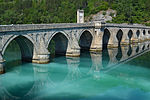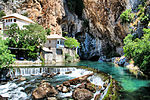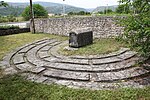利用者:ロイヤルオーク/sandbox/下書き7
The United Nations Educational, Scientific and Cultural Organization (UNESCO) World Heritage Sites are places of importance to cultural or natural heritage as described in the UNESCO World Heritage Convention, established in 1972.[1] Bosnia and Herzegovina inherited the former country of Yugoslavia's accession to the convention on 12 July 1993 as one of the successor states.[2]
2018年現在[update], there are three sites in Bosnia and Herzegovina on the list and a further 11 on the tentative list (the official list of sites that may be considered for future submission).[2] The first site, the Old Bridge Area of the Old City of Mostar, was inscribed to the list at the 29th UNESCO session in 2005.[3] In 1993, during the Bosnian War, it was destroyed by the Croatian Defence Council in an artillery barrage. It was reconstructed after the conflict and reopened in 2004.[3] In 2007, the Mehmed Paša Sokolović Bridge in Višegrad was inscribed to the list.[4] This was followed by the inscription of the Stećci Medieval Tombstones Graveyards in 2016. The latter is a transnational site, which is also partly in Croatia, Serbia, and Montenegro. Out of 28 listed Stećci sites, 20 are located in Bosnia and Herzegovina, with the most prominent one in Radimlja.[5]
World Heritage Sites
[編集]UNESCO lists sites under ten criteria; each entry must meet at least one of the criteria. Criteria i through vi are cultural, whereas vii through x are natural.[6]
| Site | Image | Location (municipality) | Year listed | UNESCO data | Description |
|---|---|---|---|---|---|
| Old Bridge Area of the Old City of Mostar | 
|
Mostar | 2005 | 946; vi (cultural) |
This site encompasses the Old Bridge and the surrounding area. The Ottoman bridge, which crosses the Neretva river, was commissioned by Suleiman the Magnificent and completed in 1566/67. In 1993, during the Bosnian War, it was deliberately shelled and destroyed by the Croatian Defence Council. After the war, the bridge was rebuilt using traditional construction methods and local materials, and reopened in 2004.[3] |
| Mehmed Paša Sokolović Bridge | 
|
Višegrad | 2007 | 1260; ii, iv (cultural) |
The Mehmed Paša Sokolović Bridge, which crosses the Drina river, was completed in 1577 by the Ottoman court architect Mimar Sinan on the orders of the Grand Vizier Mehmed Paša Sokolović.[4] |
| Stećci Medieval Tombstones Graveyards* | 
|
20 sites | 2016 | 1504; iii, vi (cultural) |
Stećci (sing. stećak) are the monolith medieval tombstones found in modern-day Bosnia and Herzegovina, as well as parts of Croatia, Serbia, and Montenegro. They first appeared in the 12th century and reached their peak in the 14th and 15th centuries. There are 20 sites in Bosnia and Herzegovina, mostly in the southeastern part of the country. The largest cluster is located in Radimlja, in the Stolac municipality.[5] |
Tentative list
[編集]In addition to the sites inscribed on the World Heritage list, member states can maintain a list of tentative sites that they may consider for nomination. Nominations for the World Heritage list are only accepted if the site was previously listed on the tentative list.[7] As of 2019, Bosnia and Herzegovina recorded eleven sites on its tentative list.[8]
| Site | Image | Location (municipality) | Year listed | UNESCO criteria | Description |
|---|---|---|---|---|---|
| Sarajevo – unique symbol of universal multiculture – continual open city (N.I.) | 
|
Sarajevo | 1997 | v (cultural) |
Sarajevo, the capital of Bosnia and Herzegovina, has a long and rich history of religious and cultural diversity.[9] |
| Vjetrenica cave | 
|
Ravno | 2004 | vii, x (natural) |
Vjetrenica (meaning "the wind cave") is the largest cave in Bosnia and Herzegovina. In the warmer parts of the year, cold air blows from its entrance. It is an important biodiversity spot. Fossils of prehistoric carnivores have been found in the cave.[10] |
| The natural and architectural ensemble of Jajce | 
|
Jajce | 2006 | ii, iii, iv, v, vi, vii (mixed) |
The city of Jajce is located at the confluence of the Pliva and Vrbas rivers. It was founded in the Middle Ages and acquired its final form during the Ottoman period.[11] |
| The historic urban site of Počitelj | 
|
Čapljina | 2007 | ii, iii, iv, v, vi (cultural) |
The city of Počitelj presents one of the few urban ensembles in Bosnia and Herzegovina preserved in their integrity from the medieval and Ottoman periods.[12] |
| The natural and architectural ensemble of Blagaj | 
|
Mostar | 2007 | ii, iii, iv, v, vi, vii (mixed) |
The town of Blagaj, situated at the spring of the Buna river, contains several examples of Ottoman architecture, such as the Blagaj Tekke.[13] |
| The natural and architectural ensemble of Blidinje | 
|
Jablanica, Posušje, Tomislavgrad | 2007 | i, iii, iv, v, vi, vii, viii, ix (mixed) |
The Blidinje Nature Park area is an example of the geological processes that took place during the orogenesis of the Dinarides, as well as an example of the evolutionary development of postglacial flora and fauna. The area features a wide range of endemic plant communities and contains several stećak tombstones.[14] |
| The natural and architectural ensemble of Stolac | 
|
Stolac | 2007 | ii, iii, iv, v, vi, vii (mixed) |
The historic core of Stolac is an example of a complex cultural-historical and natural environmental ensemble. The area contains remains from prehistory, the Illyrian-Roman era, the Middle Ages, and the Ottoman, Austro-Hungarian, and Yugoslav periods.[15] |
| Strict Nature Reserve – Primeval forest "Perućica" | 
|
Foča | 2017 | vii, ix, x (natural) |
The primeval forest of Perućica is an important biodiversity spot, home to brown bear, wolf, and lynx, as well as to several species of birds, reptiles, and amphibians. Its mountain creek forms the 75 m (246 ft) high Skakavac Waterfall.[16] |
| Jewish Cemetery in Sarajevo | 
|
Sarajevo | 2018 | ii, iii, iv, vi (cultural) |
The burial complex lies on a steep site and covers a total area of 31,160 m2 (335,400 sq ft). There are more than 3,850 tombstones in a total of seven plots, along with four memorials erected to the victims of World War II fascist terror and several cenotaphs. The complex also includes a large Ashkenazi ossuary built in 1962 following the exhumation of the old and the new Ashkenazi graveyards. In 1966, the cemetery was closed for burials. It is believed that the Geniza (a graveyard for worn out books) is located in the southeastern part of the cemetery.[17] |
| Ancient and Primeval Beech Forests of the Carpathians and Other Regions of Europe (extension) | 
|
Šipovo | 2019 | ix (natural) |
This is an extension to the site, already listed in several European countries, documenting the evolution and spread of European beech. In Bosnia and Herzegovina, the nomination includes the Strict Nature Reserve - Primeval forest Janj.[18] |
| Complex of travertine waterfalls in Martin Brod - Una National Park | 
|
Bihać | 2019 | vii, ix (natural) |
The upper stream of river Una features a series of waterfalls and travertine formations and is an important biodiversity spot.[19] |
See also
[編集]- List of National Monuments of Bosnia and Herzegovina
- List of protected areas of Bosnia and Herzegovina
References
[編集]- ^ “UNESCO World Heritage Centre – The World Heritage Convention”. UNESCO World Heritage Centre. 27 August 2016時点のオリジナルよりアーカイブ。25 October 2015閲覧。
- ^ a b “Bosnia and Herzegovina”. UNESCO World Heritage Centre. 3 August 2017時点のオリジナルよりアーカイブ。25 July 2017閲覧。
- ^ a b c “Old Bridge Area of the Old City of Mostar”. UNESCO World Heritage Centre. 28 December 2017時点のオリジナルよりアーカイブ。25 December 2017閲覧。
- ^ a b “Mehmed Paša Sokolović Bridge in Višegrad”. UNESCO World Heritage Centre. 27 December 2017時点のオリジナルよりアーカイブ。25 December 2017閲覧。
- ^ a b “Stećci Medieval Tombstone Graveyards”. UNESCO World Heritage Centre. 17 September 2017時点のオリジナルよりアーカイブ。25 December 2017閲覧。
- ^ “UNESCO World Heritage Centre – The Criteria for Selection”. UNESCO World Heritage Centre. 12 June 2016時点のオリジナルよりアーカイブ。17 August 2018閲覧。
- ^ “UNESCO World Heritage Centre – Tentative Lists”. UNESCO World Heritage Centre. 20 July 2017時点のオリジナルよりアーカイブ。25 July 2017閲覧。
- ^ “UNESCO World Heritage Centre – Tentative Lists: Bosnia and Herzegovina”. UNESCO World Heritage Centre. 16 July 2017時点のオリジナルよりアーカイブ。25 July 2017閲覧。
- ^ “Sarajevo – unique symbol of universal multiculture – continual open city (N.I.)”. UNESCO World Heritage Centre. 10 January 2018時点のオリジナルよりアーカイブ。25 December 2017閲覧。
- ^ “Vjetrenica cave”. UNESCO World Heritage Centre. 10 January 2018時点のオリジナルよりアーカイブ。25 December 2017閲覧。
- ^ “The natural and architectural ensemble of Jajce”. UNESCO World Heritage Centre. 10 January 2018時点のオリジナルよりアーカイブ。25 December 2017閲覧。
- ^ “The historic urban site of Počitelj”. UNESCO World Heritage Centre. 17 December 2017時点のオリジナルよりアーカイブ。25 December 2017閲覧。
- ^ “The natural and architectural ensemble of Blagaj”. UNESCO World Heritage Centre. 17 February 2010時点のオリジナルよりアーカイブ。25 December 2017閲覧。
- ^ “The natural and architectural ensemble of Blidinje”. UNESCO World Heritage Centre. 10 January 2018時点のオリジナルよりアーカイブ。25 December 2017閲覧。
- ^ “The natural and architectural ensemble of Stolac”. UNESCO World Heritage Centre. 15 November 2017時点のオリジナルよりアーカイブ。25 December 2017閲覧。
- ^ “Strict Nature Reserve – Primeval forest "Perućica"”. UNESCO World Heritage Centre. 20 September 2017時点のオリジナルよりアーカイブ。25 December 2017閲覧。
- ^ “Jewish Cemetery in Sarajevo”. UNESCO World Heritage Centre. 3 July 2018時点のオリジナルよりアーカイブ。3 July 2018閲覧。
- ^ “Ancient and Primeval Beech Forests of the Carpathians and Other Regions of Europe - extension (Bosnia and Herzegovina)”. UNESCO World Heritage Centre. 7 July 2019閲覧。
- ^ “Complex of travertine waterfalls in Martin Brod - Una National Park”. UNESCO World Heritage Centre. 7 July 2019閲覧。
Template:World Heritage Sites in Bosnia and Herzegovina Template:Lists of World Heritage Sites in Europe
